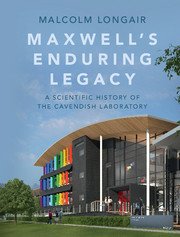Book contents
- Frontmatter
- Dedication
- Contents
- Preface
- Acknowledgements
- Part I To 1874
- Part II 1874 to 1879
- Part III 1879 to 1884
- Part IV 1884 to 1919
- Part V 1919 to 1937
- 8 Rutherford at McGill and Manchester universities: new challenges in Cambridge
- 9 The Rutherford era: the radioactivists
- 10 The Rutherford era: the seeds of the new physics
- Part VI 1938 to 1953
- Part VII 1953 to 1971
- Part VIII 1971 to 1982
- Part IX 1984 to 1995
- Part X 1995 to present
- Appendix The evolution of the New Museums site
- Notes
- References
- Author index
- Subject index
8 - Rutherford at McGill and Manchester universities: new challenges in Cambridge
from Part V - 1919 to 1937
Published online by Cambridge University Press: 05 July 2016
- Frontmatter
- Dedication
- Contents
- Preface
- Acknowledgements
- Part I To 1874
- Part II 1874 to 1879
- Part III 1879 to 1884
- Part IV 1884 to 1919
- Part V 1919 to 1937
- 8 Rutherford at McGill and Manchester universities: new challenges in Cambridge
- 9 The Rutherford era: the radioactivists
- 10 The Rutherford era: the seeds of the new physics
- Part VI 1938 to 1953
- Part VII 1953 to 1971
- Part VIII 1971 to 1982
- Part IX 1984 to 1995
- Part X 1995 to present
- Appendix The evolution of the New Museums site
- Notes
- References
- Author index
- Subject index
Summary
The changing frontiers of physics research
The outbreak of the First World War brought much of the research activity in UK universities to a halt. In particular, as indicated in Section 7.8, a whole generation of young men enlisted with tragic loss of life in the trenches of northern France, Belgium and the Low Countries. Although the attentions of experimental physicists had to turn to military-related topics, the theorists who remained in the universities throughout Europe continued to produce work of the highest quality. Perhaps most spectacular of all were the contributions of Einstein. As expressed by Pais,
Einstein's productivity was not affected by the deep troubles of the war years, which, in fact, rank among the most productive and creative of his career. During this period, he completed the general theory of relativity, found correct values for the bending of light and the displacement of the perihelion of Mercury, did pioneering work in cosmology and gravitational waves, introduced his A and B coefficients for radiative transitions, found a new derivation of Planck's radiation law – and ran into his first troubles with causality in quantum mechanics. During the war, he produced, in all, one book and about fifty papers, …(Pais, 1982)
At the same time, Einstein became an outspoken radical pacifist, which provoked a hostile reaction from the authorities in the midst of a devastating war.
By the end of the war, there had been major advances in the efforts to incorporate quantum concepts into physics at the atomic level, what is conveniently referred to as the old quantum theory. This was to continue in the years immediately following the war until the quantum revolution of 1925–27, associated with the names of Heisenberg, Born, Jordan, Dirac, Schrödinger, Pauli and many others.
- Type
- Chapter
- Information
- Maxwell's Enduring LegacyA Scientific History of the Cavendish Laboratory, pp. 171 - 193Publisher: Cambridge University PressPrint publication year: 2016



